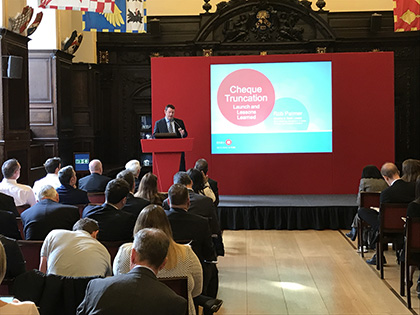
Rob Palmer from Bank of Montreal addresses the audience at the 3rd Annual Cheque Imaging Conference in London.
Earlier this month, around 40 representatives from Britain’s major banks joined us in London for the Third Annual Conference on Cheque Imaging and Remote Deposit Capture – a yearly event that Digital Check has held in conjunction with its UK partner the TALL Group. This year’s conference held special importance, coming on the eve of the country’s transition to the new Image Clearing System (ICS) beginning in the last week of October.
In addition to delegates from Digital Check and the TALL Group, speakers included Stuart Cole from industry standard-setter the Cheque and Credit Clearing Company, and Rob Palmer from Bank of Montreal, who spoke about his own bank’s experience with introducing check capture and remote deposit when it became legal in Canada in 2014. Attendees also shared some of their own plans for rolling out image capture in its various forms.
British banks look to be taking a much different track to introducing check imaging than the United States did back in 2004, in no small part because the technology available today is far more advanced than what was available more than a decade ago. In particular, fraud prevention tools such as duplicate detection and risk assessment are being built into the overall system from the start – a technology that didn’t exist when the U.S. launched its system and which has proved difficult to add retroactively. Since checks in the UK also incorporate ultraviolet security printing, banks may also have the option to conduct automated screening to weed out suspicious items, based on an analysis of the invisible UV ink layer.
The ICS is also based on a “switch” architecture instead of the central electronic clearinghouse model – meaning that clearing takes place closer to real-time, and also allows for the possibility of non-banks (such as corporate treasury departments) to access the network directly.
It appears that most banks in Britain are planning to go with teller capture, not back-counter branch capture. The reason, somewhat surprisingly, is that a number of banks have already had check scanners deployed at the teller window for years – not for electronic clearing purposes, but as a branch productivity tool to reduce paperwork, and to capture at least the MICR codeline. While not every bank has moved to such a system, several of the major ones already have it in place, making the transition somewhat easier for them.
The general market consensus for remote deposit is that mobile capture will come before desktop, as there’s a lot of emphasis on mobile banking in the UK. Mobile RDC has also proven to generate the most hype in other countries that have introduced check capture recently – including Canada and Brazil – so the pressure is on to be quick to market.
Because Britain is employing a “soft” rollout of image-based clearing – some banks will exchange some checks via the new process next month, but full participation won’t be required until sometime in 2018 – it appears the path to remote deposit will be more relaxed than it was in Canada or Brazil. Most attendees expected about a six-month lag time from the initial pilot-like phase of intrabank clearing to the introduction of customer-facing RDC.
As BMO’s Palmer pointed out, Canada’s banking system probably resembles the UK’s more closely than any other in the world, with the two countries sharing similar numbers of banks, checks, and customers, and with very similar technology available at the launch of truncation. The Canadian rollout may have been the smoothest in the world so far, and as its electronic clearing system approaches its third anniversary, participation is nearly total and remote capture has seen rapid uptake. That remains the ideal case to beat, but attendees at the conference were encouraged to hear that Britain is more or less on track to match it.
The new electronic system is expected to reduce clearing times by up to five days: Currently, paper checks are delivered to the central clearing hub by rail for routing to the receiving institutions; however, under the new rules, all items deposited on weekdays will clear by 11:59 pm on the following business day.
Most attendees at the conference agreed on the need to fully communicate their plans ahead of the ICS rollout, enabling customers to take advantage of the new funds availability rules and, eventually, remote capture opportunities.





